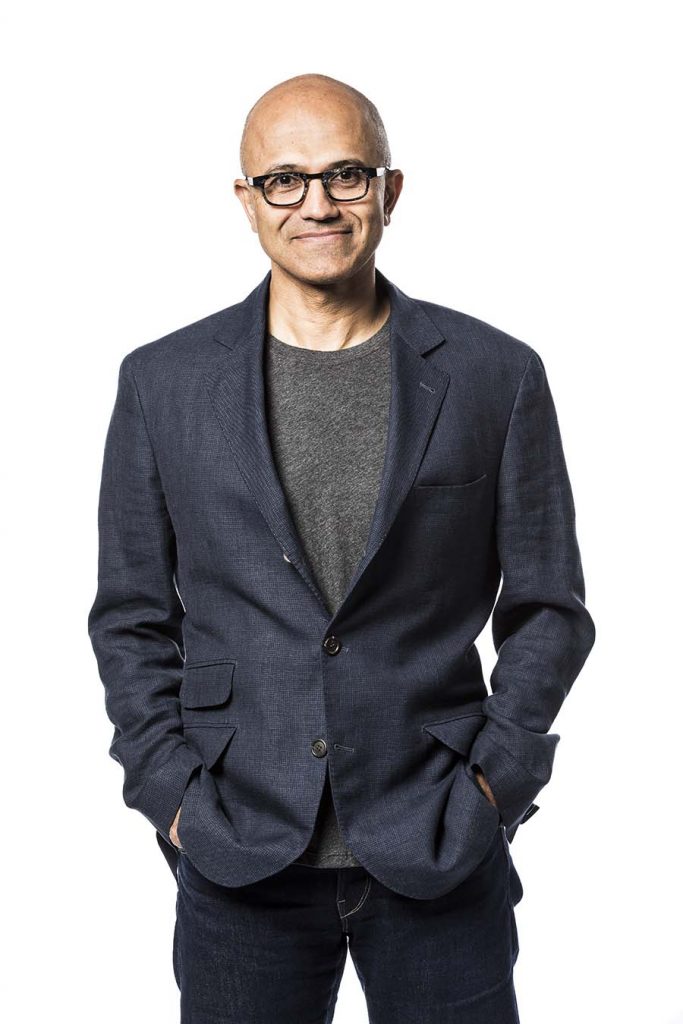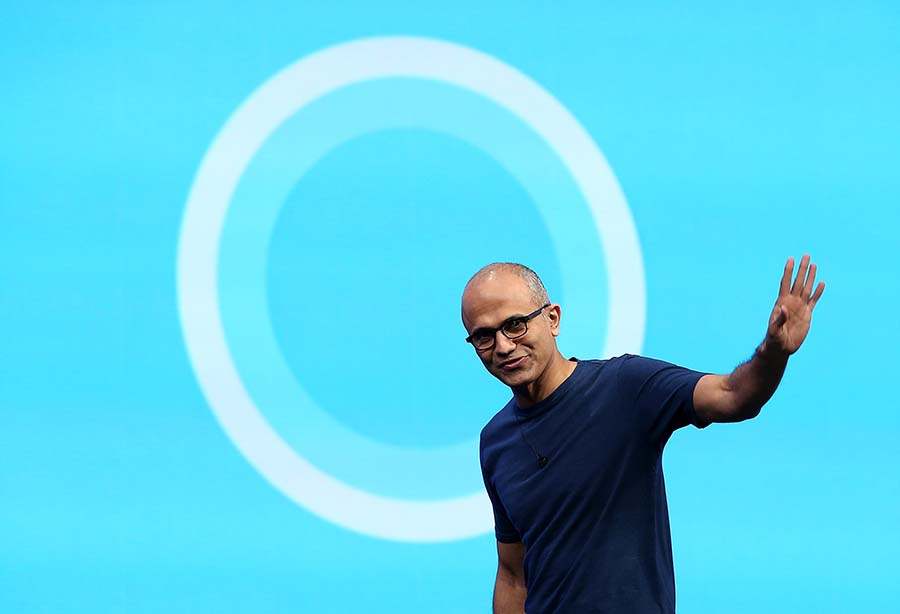When Satya Nadella became CEO eight years ago, he had a vision to transform one of the world’s largest corporations into a profit-making machine. He used a leadership style that characterizes clear vision, open communication, courage, humility, empathy, and a capacity to generate energy among his colleagues and teams. In interviews and quotes over almost a decade, Nadella explains his unique approach to leadership — that delivers incredible profits and puts social impact into everything he does.
Ultimately, our culture will determine the lengths of what we will achieve,” says Microsoft CEO Satya Nadella in his latest annual report letter. “Care is the new currency for every leader.” Nadella, an Indian-American executive who succeeded Steve Ballmer in 2014, is the third CEO in the company’s history, walking in the footsteps of Bill Gates, who founded the multinational tech corporation in 1975.
Under Nadella, Microsoft revised its mission statement to “empower every person and every organization on the planet to achieve more,” and he has orchestrated a cultural shift at the company by emphasizing empathy, collaboration, and a growth mindset. With a penchant for life-long learning, he has also transformed Microsoft’s corporate culture into one that emphasizes continuous learning and growth, which has helped company profits and social impact. Staying true to this commitment to learning and diversity of thought, he is a board director for Starbucks, the Fred Hutchinson Cancer Research Center, and the University of Chicago. You’ll never know when a great idea for coffee might find its way into your software program, but that’s the point — great ideas can come from anywhere.
Nadella is also an avid reader of American and Indian poetry and has a passion for cricket. This well-rounded leadership style has become entrenched in the broader Microsoft culture. It embodies the mantra that you first must lead yourself before leading others effectively.
You Are a Product of Those Who Came Before
Nadella cites his parents as having the most significant influence on him. He explained how the mismatched personalities of his parents helped build his unique world-view during a discussion at Stanford School of Business in 2019. “My father was an economist, leftist Marxist, and my mother was a Sanskrit drama professor. They could hardly agree on anything, giving me room to form my own opinions. The way my father combined his work with his life’s passions, the deep meaning he derived from it, has been instrumental in shaping my views of work and life,” says Nadella. His father told him that life is a terminal condition, and no one makes it out alive, but that one’s life can speak to others by passing on what is most important about being human and how to live.
“The world is confronting massive and compounding challenges,” Nadella explained to the Stanford audience. “Our mission to empower every person and every organization on the planet to achieve more has never been more urgent or needed. To realize this mission, we must ensure the technology we create benefits everyone on the planet and the planet itself by focusing on four interconnected pillars: Support inclusive economic opportunity, protect fundamental rights, create a sustainable future, and earn trust. As we share our progress in these areas, it reminds us that we are only as good as our commitment to keep learning, adapting, and empowering others to act. To drive real, structural change in the world, we must make a sustained commitment — together.”
Succession: How to Fill Those Big Shoes
“The best advice I got from Steve Ballmer and Bill Gates when I came onboard as CEO was not to try and be like them. Their clear message was that I shouldn’t bother giving the impression that I was succeeding these two people, but rather create my own identity,” Nadella explained to Bloomberg’s David Rubenstein in 2017.
“I remember in the interview process conducted by the board, I was asked, ‘Do you want to be the CEO?’ I answered, ‘Only if you want me to be the CEO.’ The feedback I got was that ‘People who want to be CEO say they really want to become CEO.’ I said, ‘But that’s not me.’” When Nadella spoke with Ballmer a short while later, he was told, “Just be yourself; it’s too late to be different.” When you take over a multi-billion-dollar company such as Microsoft, it can be challenging to say to two industry greats such as Gates and Ballmer that you no longer like what they did and that you’d like to change things. “I was a consummate insider at Microsoft for 25 years,” Nadella explained to Rubenstein. “Growing up in the company under Bill and Steve allowed me to see what they got wrong and right. I already had a point of view on what I wanted to do if I became CEO. It wasn’t about trying to criticize the past, but more about what we needed to do for the future.”
Ironically, one of the first things Nadella did when he became CEO was to ask founder Bill Gates to spend more time at the company. Gates agreed to spend a third of his time meeting with development groups. “It will be fun to help define this next round of products, working together,” Gates said in a welcome video, showing that humbleness and servant leadership can even apply to one of the world’s wealthiest individuals.

Qualities to Look for when Hiring
“The one trait I look for in new hires is whether they create clarity and energy,” said Nadella in conversation with Gerard Baker in 2016. He wants to flip the employer-employee equation around. “What if you change this equation? Instead of saying ‘I work for Microsoft,’ what if Microsoft worked as a platform for every one of our more than 220,000 people? Throughout his years at the company, before becoming CEO, Nadella had marveled at what a great platform it was to have an impact. “That’s what made me stay and be ambitious,” he says. “Of course, a CEO has to live the culture, but if you can switch on every employee’s mindset to think that the company is working for them, then you’ve really achieved something. Also, don’t wait for your next job to do your best work. Think about every job you get as the most important job,” he told Baker.
Creating a Culture of Collaboration
Nadella reads and writes poetry and is fond of quoting lines that help stress his point in meetings and speeches. This unusual pastime came about on a flight many years ago with one of his first managers, that he described to Walter Isaacson, former CEO of the Aspen Institute in 2014. “I had brought around 15 magazines to read on the flight,” recalls Nadella. But then the manager hauled out a book on Irish novelist and poet James Joyce and started reading. “I looked at him and said, ‘What the heck are you doing?’ He replied, “This is the way to renew yourself.” It was a moment of realization for Nadella, who had assumed that the latest news and trends in the magazines were of paramount importance. Instead, new inspirations and ways of thinking might be found in poems from the early 1900s. Despite his love for English and American poets, the haunting words and imagery of Indian Urdu poetry of the 17th and 18th centuries inspires Nadella the most.
Ideas of innovation can be found in poems by American-British poet T.S. Eliot, who wrote: “We shall not cease from exploration, and the end of all our exploring will be to arrive where we began and to know the place for the first time.” The lesson here is that humanity will want to progress, but once it does, it will return to where it started and understand what drove it to progress in the first place. Deep thoughts and ponderings like these feed Nadella’s quest for meaning and ultimately find their way into his leadership style and company values.
In 2014, when Nadella took the helm at Microsoft, the company had a very proprietary culture and mindset that suggested, “This is how we do things. We don’t necessarily want to cooperate with other firms or competitors.” Nadella changed this mindset and became more collaborative across the board, from customers to competitors. Three years later, he explained to Rubenstein his thinking in this regard. “I started by not viewing things as a zero-sum game,” says Nadella. “Customers are heterogenous by nature; they will engage with some of what we do and some of what our competitors do. My approach was to figure out a way to combine forces so that it was both market-expansive and satisfied customers.”
What Nadella did next catapulted Microsoft into huge profitability. Within four years, by 2018, Microsoft stock had tripled and showed a 27% annual growth rate.
Nadella set out on an acquisition trail to support this idea of collaboration, which included Microsoft’s biggest acquisition ever — the purchase of professional network LinkedIn in 2016 for $26.2 billion. At the time, people couldn’t see the reasoning for this considerable investment. What did Microsoft, a software company, have to do with an online networking platform?
“At the time, we had 1 billion users of Windows and Office,” Nadella told Rubenstein in a 2017 interview. “The common thread between all these users was that they are professionals, people trying to get things done. We had professional cloud software and devices. Our vision was to connect that with a professional network that brought content and people together to become a big driver of productivity.”
A game-changer for Microsoft was the realization that LinkedIn is where many people make business-to-business sales. Integrating Microsoft tools and LinkedIn has revolutionized how many companies target and reach customers. Collaboration through acquisition can sometimes benefit both parties and move away from the loose, non-committal arrangements many collaborations can fall into. In the five years since Microsoft acquired LinkedIn, revenue has nearly tripled, and growth has accelerated.
The next big step in collaboration is harnessing big data’s power. Microsoft is creating the Planetary Computer, which combines a multi-petabyte catalog of global environmental data with intuitive APIs, allowing users to answer global questions about that data and putting answers in the hands of conservation stakeholders. The global environmental organization, The Nature Conservancy, is already using the Planetary Computer to protect and manage land, oceans, and freshwater biodiversity.
His One Big Mistake
High-level leadership is not always about praise and big wins; sometimes, you hit a bump. Nadella’s big bump happened at the very beginning, in 2014, shortly after becoming CEO. Nadella was asked about pay equity at the Grace Hopper Celebration of Women in Computing conference in Phoenix by Harvey Mudd College president Maria Klawe, who was on Microsoft’s board of directors at the time. Nadella replied that women should trust “karma” instead of asking for pay raises and suggested that the “system” would reward their work. He apologized the next day, saying he was “completely wrong.”
“I gave a nonsensical answer, and Maria was kind enough to correct me,” Nadella told Rubenstein. “I answered the question using my own experience, without understanding the broader context and the depth of that question, which was: What was a person like me, the CEO of a company, doing to make sure that women can fully participate in our companies and economies? It wasn’t about what worked for me in my life.” It was a great learning moment for Nadella, and the gravity of the issue was amplified when he spoke with high-level female executives at Microsoft, who made him aware that investing in gender and ethnic diversity at Microsoft would filter through to their diverse customer base and build greater loyalty. “I’m glad I messed up so publicly because I internalized the lessons from it,” says Nadella.
In his latest shareholder letter, Nadella expressed this sentiment further: “We know that as we become more representative of the communities where we live and work, and the people around the world whom we aspire to serve, we become better at helping everyone on the planet achieve more.
Leading with Empathy
Nadella’s son, Zain, was born with cerebral palsy and died in February, at age 26. The experience has made Nadella more empathetic and given depth to his leadership. In 2020, in a conversation with Klaus Schwab at the World Economic Forum, Nadella explained his initial confusion about why this had happened to him. “For the first two years, I wondered, ‘why me?’” recalls Nadella. “My wife Anu had a natural love for Zain, and the commitment she made by giving up her job as an architect to care for him taught me something. It schooled me, and I realized that nothing had actually happened to me; it had happened to my son. It was time to see his life through my eyes and to do my duty as a father.” It changed who Nadella was and gave him the quality of empathy, which made him a better CEO and person. “Most people think that empathy is something you reserve for friends and family,” says Nadella. “Yet, it’s an existential reality for business. Our business is to meet the unmet, unarticulated needs of customers. There is no way this will come about if we don’t listen — not just the words but the needs behind the words. Empathy is core to innovation. Life’s experiences, if you listen and learn from them, teach you. My pursuit is to ask myself each year if there’s a growing sense of empathy for the people around me.”
Thoughts on Leadership
As Nadella moved through his journey as CEO, he had to adjust his expectations and abilities to others in the company. In a discussion with David Rubenstein in 2019, he expressed a realization that a holistic awareness is key. “I had to grapple with what only I could do versus what others in the team could do. Getting better at it was the most helpful.” The most significant adjustment Nadella faced as CEO was realizing how multi-constituent the job was. “It’s about customers, partners, employees, investors, even governments. It’s about all of them, all the time.” How you think about this world is the biggest adjustment you can make as you grow an organization, and the faster you grapple with it, the better off you’ll be.”




































